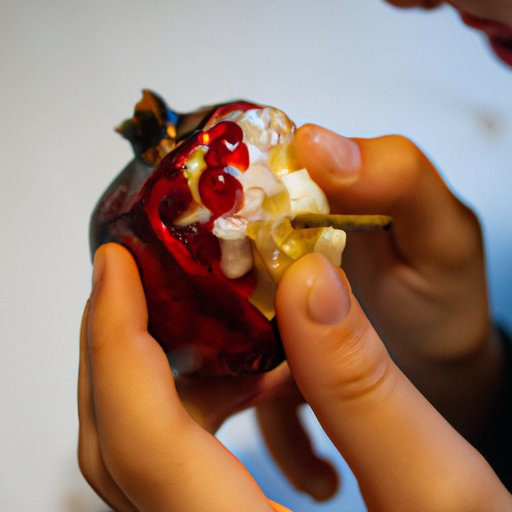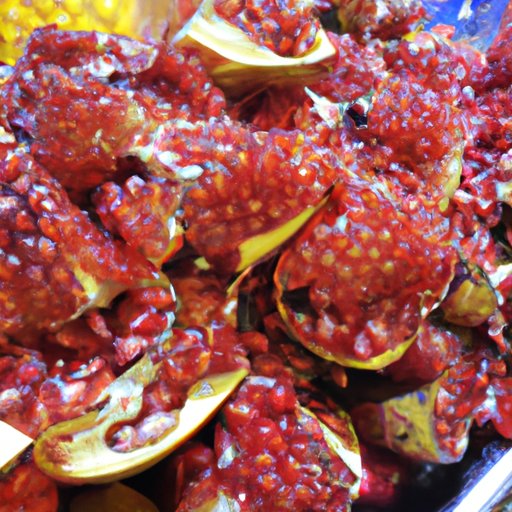Introduction
Pomegranates are a unique and flavorful fruit that can be enjoyed in a variety of ways. They have been used for centuries in many cultures around the world, and they offer a wide range of health benefits. In this article, we will explore how to select, prepare, and eat pomegranates, as well as some creative ways to use them in recipes. We will also look at their nutritional value and health benefits.
How to Select the Perfect Pomegranate
When selecting a pomegranate, you should look for one that is firm and heavy for its size. The color should be a deep red-purple, and the skin should be smooth and glossy. Avoid any that have cracks or blemishes, as these may indicate that the pomegranate is not fresh. Since pomegranates do not continue to ripen after they are picked, look for one that is ripe and ready to eat.
To determine if a pomegranate is ripe, give it a gentle squeeze. If it feels soft, it is likely overripe. You should also check the weight of the pomegranate. It should feel heavier than it looks, as this indicates that it is full of juice.

Preparing and Eating a Pomegranate
Once you have selected a ripe pomegranate, it is time to prepare it for eating. Here is a step-by-step guide for cutting and seeding a pomegranate:
- Cut off the top of the pomegranate.
- Score the sides of the pomegranate into sections.
- Soak the pomegranate in a bowl of cold water for 5 minutes.
- Gently pull apart the sections of the pomegranate.
- Remove the seeds from the membranes and place them in a bowl.
- Discard the membranes and any white pith.
Once the pomegranate is seeded, you can enjoy it as is or add it to salads, desserts, main dishes, and more. Here are some creative ways to use pomegranate in recipes:
Salads
Adding pomegranate seeds to salads is a great way to add flavor and texture. The sweet and tart taste of the seeds pairs perfectly with greens, nuts, and other salad ingredients. Try adding pomegranate seeds to your favorite salad recipe for a burst of flavor.
Desserts
Pomegranate seeds make a great topping for cakes, pies, tarts, and other desserts. They add a pop of color and sweetness to any treat. You can also use pomegranate juice in place of other liquids in recipes for an extra boost of flavor.
Main Dishes
Pomegranate seeds can be used as a garnish on main dishes such as fish, chicken, and pork. They add a unique flavor and texture to any meal. Pomegranate juice can also be used in marinades and sauces for added flavor.
Health Benefits of Pomegranate
Pomegranates are packed with nutrients and antioxidants, which can offer a number of health benefits. Here are some of the potential benefits of eating pomegranates:
Antioxidants
Pomegranates are rich in antioxidants, which help protect the body from oxidative damage caused by free radicals. This can reduce the risk of chronic diseases such as cancer and heart disease.
Heart Health
The antioxidants in pomegranate can also help lower cholesterol levels and improve blood flow, which can help reduce the risk of heart disease.
Anti-Inflammatory Effects
Pomegranates contain compounds that may help reduce inflammation in the body. This can help relieve symptoms of arthritis and other inflammatory conditions.

Tips for Storing Fresh Pomegranates
If you have purchased more pomegranates than you can eat at once, there are several ways to store them for later use. Here are some tips for storing fresh pomegranates:
Refrigeration
You can store pomegranates in the refrigerator for up to two weeks. To keep them fresh longer, wrap them in plastic wrap or place them in an airtight container.
Freezing
Pomegranates can also be frozen for up to six months. To freeze them, remove the seeds from the pomegranate and place them in an airtight container or freezer bag. When you are ready to use them, simply thaw them in the refrigerator overnight.
Canning
You can also can pomegranate seeds to preserve them for later use. To do this, cook the seeds in a simple syrup and then process them in a hot water bath for 10 minutes. Be sure to follow all safety guidelines when canning food.
Nutritional Value of Pomegranates
Pomegranates are a good source of vitamins and minerals, including vitamin C, potassium, and folate. They are also low in calories and high in fiber, making them a healthy addition to any diet. Here is a breakdown of the nutritional value of pomegranates per 100 grams:
- Calories: 83
- Carbohydrates: 18 g
- Fiber: 4 g
- Vitamin C: 14% of the RDI
- Potassium: 12% of the RDI
- Folate: 11% of the RDI
Conclusion
Pomegranates are a delicious and nutritious fruit that can be enjoyed in a variety of ways. They offer a wide range of health benefits, including antioxidant and anti-inflammatory properties. With their sweet and tart flavor, they can be added to salads, desserts, and main dishes for an extra burst of flavor. Now that you know how to select, prepare, and eat pomegranates, why not give them a try?
For more information on the health benefits of pomegranates, as well as creative ways to use them in recipes, be sure to check out the resources below. Happy eating!
Suggestions for Further Reading:
- Health Benefits of Pomegranate
- How to Select and Store Pomegranates
-
(Note: Is this article not meeting your expectations? Do you have knowledge or insights to share? Unlock new opportunities and expand your reach by joining our authors team. Click Registration to join us and share your expertise with our readers.)
